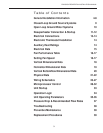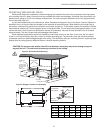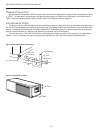
4
ENVISION RESIDENTIAL INSTALLATION MANUAL
Moving and Storage
Move units in the normal “up” orientation. Horizontal units may be moved and stored per the information on the packag-
ing. Do not stack more than three units in total height. Vertical units may be stored one upon another to a maximum height
of two units. Do not attempt to move units while stacked. When the equipment is received, all items should be carefully
checked against the bill of lading to be sure all crates and cartons have been received. Examine units for shipping damage,
removing the units from the packaging if necessary. Units in question should also be internally inspected. If any damage is
noted, the carrier should make the proper notation on the delivery receipt, acknowledging the damage.
Unit Location
Locate the unit in an indoor area that allows for easy removal of the fi lter and access panels. Location should have
enough space for service personnel to perform maintenance or repair. Provide suffi cient room to make water, electrical
and duct connection(s). If the unit is located in a confi ned space, such as a closet, provisions must be made for return air
to freely enter the space by means of a louvered door, etc. Any access panel screws that would be diffi cult to remove after
the unit is installed should be removed prior to setting the unit. On horizontal units, allow adequate room below the unit for
a condensate drain trap and do not locate the unit above supply piping. Care should be taken when units are located in
unconditioned spaces to prevent damage from frozen water lines and excessive heat that could damage electrical
components.
Installing Vertical Units
Prior to setting the unit in place, remove and discard the compressor hold down
shipping bolt located at the front of the compressor mounting bracket.
Vertical units are available in left or right air return confi gurations. Top air dis-
charge vertical units should be mounted level on a vibration absorbing pad slightly
larger than the base to provide isolation between the unit and the fl oor. It is not
necessary to anchor the unit to the fl oor (see right).
Bottomfl ow units should be mounted level and sealed well to fl oor to prevent air
leakage. Bottomfl ow units require the supply air opening to be cut at least 1/2˝ larger
than the unit’s air outlet. Protect the edges of combustible fl ooring with sheet metal
over-wrap or other non-combustible material.
WARNING: Before performing service or maintenance operations on a system, turn off main
power switches to the indoor unit. If applicable, turn off the accessory heater power switch.
Electrical shock could cause personal injury.
Installing and servicing heating and air conditioning equipment can be hazardous due to system pressure and electrical
components. Only trained and qualifi ed service personnel should install, repair or service heating and air conditioning equip-
ment. Untrained personnel can perform the basic maintenance functions of cleaning coils and cleaning and replacing fi lters.
All other operations should be performed by trained service personnel. When working on heating and air conditioning equip-
ment, observe precautions in the literature, tags and labels attached to the unit and other safety precautions that may apply.
Follow all safety codes. Wear safety glasses and work gloves. Use a quenching cloth for brazing operations and have a
fi re extinguisher available.
Safety Considerations
General Installation Information
Figure 1: Vertical Unit Mounting
2” Extruded
Polystyrene


















